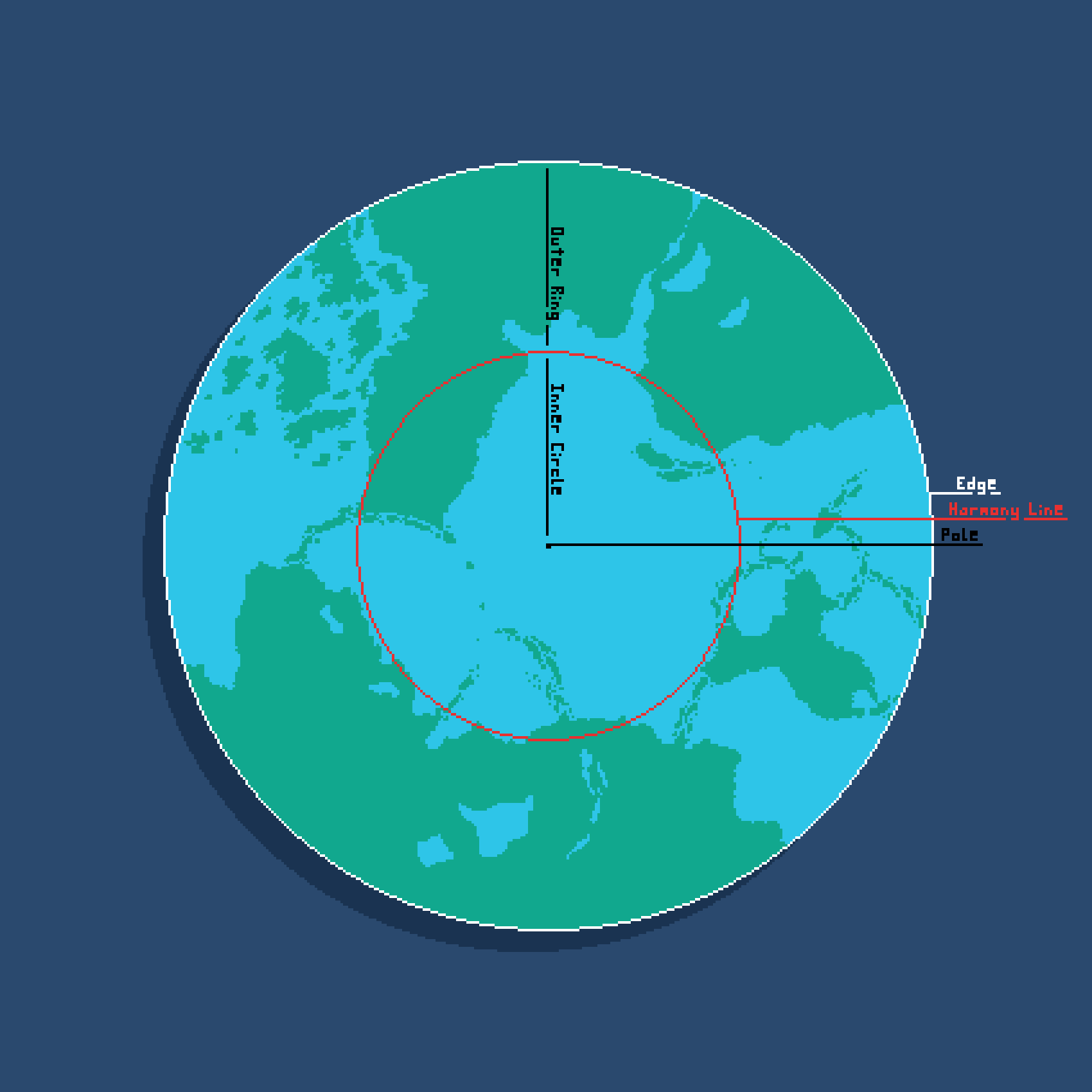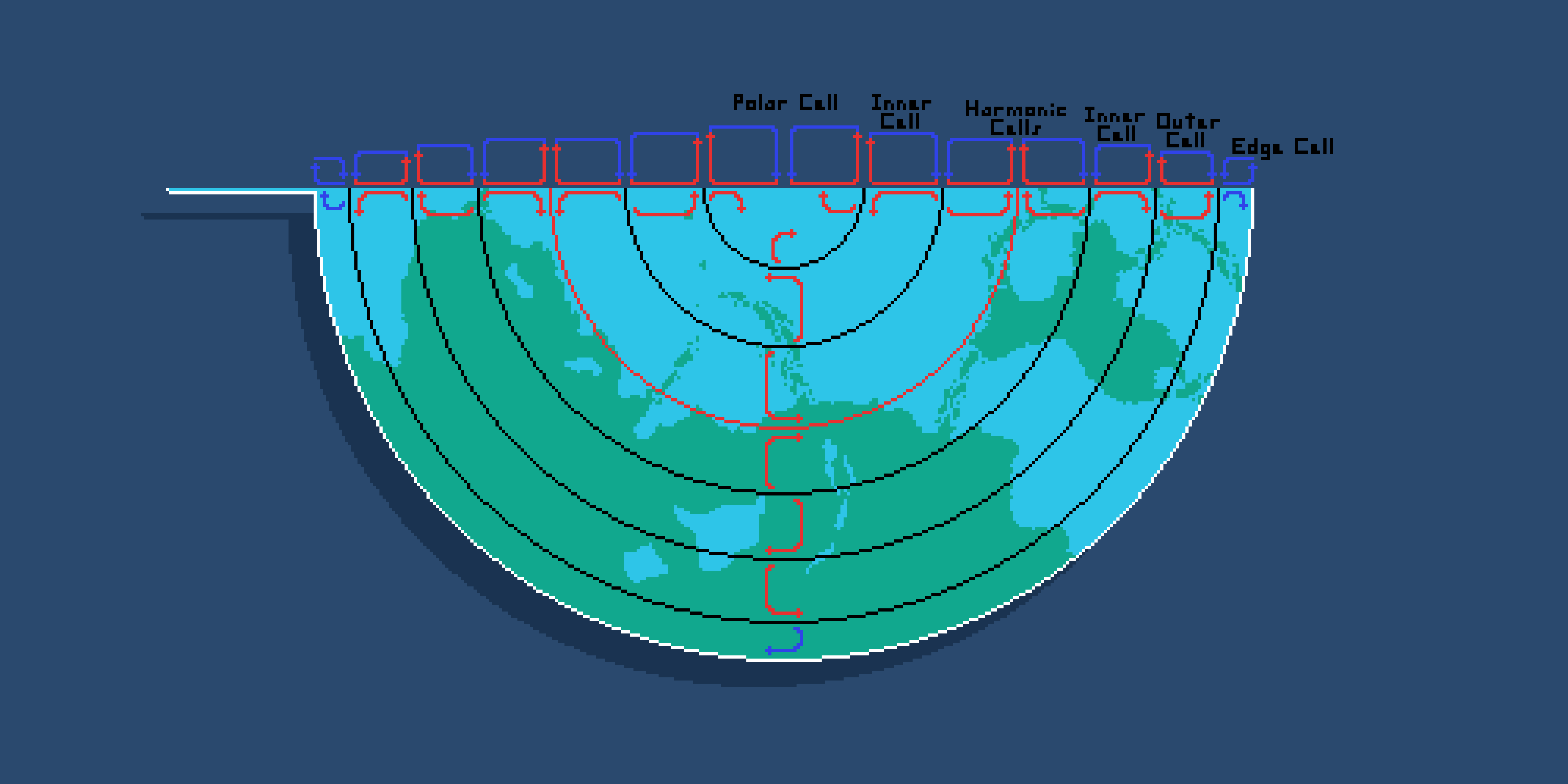Atmospheric circulation is a scientific model which describes how air in the atmosphere of the Plane moves from the central pole or edge to the harmony line and vice versa. Understanding atmospheric circulation is vital to research into weather and climate and is the primary focus of meteorological studies.
Atmospheric circulation differs slightly from year-to-year and even month-to-month as the Harmonic Treaty moves farther or closer to the surface of the Plane. Not only this, but the interactions between bands of wind in the atmosphere can be chaotic. Because of this, properly modeling the exact movements and interactions of the whole atmosphere are impossible.
The Harmonic Treaty can be described as the fuel source for atmospheric circulation, heating and gravitationally pulling on air in the atmosphere. The Harmonic Treaty moves across the sky with a slightly eccentric orbit at a slight tilt which changes throughout the year. At its furthest point the Treaty transfers the least amount of energy to the atmosphere, and at its closest transfers the most. This is what causes the seasons.
Poleward Circulation
When the orbit of the Treaty is transposed onto the surface of the Plane the line created is known as the harmony line. The harmony line is where the most energy is transferred from the Treaty to the atmosphere, because it is the closest point from the atmosphere to the Treaty at any given time. The harmony line divides the Plane into two parts, the inner circle and outer ring1.
Air at the harmony line is heated more than air at the pole or edge and this causes a circulating effect wherein air from the harmony line becomes less dense and floats upwards, creating a low-pressure zone on the surface which pulls in more dense cold air. This warm air then travels outwards and starward, pulled by the orbit of the Treaty. This warm air cools as it moves away from the harmonic line, sinking back down and creating a high-pressure zone which pushes air away. This process creates what are referred to as atmospheric cells.
Air traveling towards the edge of the Plane becomes less dense as it fills more space, cooling quicker. On the inverse, air traveling towards the pole of the Plane becomes more dense as it fills less space, cooling slower. This causes a discrepancy between the number of atmospheric cells of the inner circle and outer ring. Headed towards the pole, in the inner circle, there are 3 cells of increasingly larger diameter. Headed towards the edge, in the outer ring, there are 4 cells of increasingly smaller diameter2.
Starward Circulation
Poleward circulation may account for the majority of atmospheric circulation, but there is another more minor effect that the Treaty has on the atmosphere. As previously mentioned the Treaty orbits eccentrically, but it also orbits with a 23° tilt off of its central rotational axis. This tilt steadily changes throughout the year, with the lowest and highest points swapping twice a year3.
At all points of the year the Treaty exerts a gravitational pull, causing prevailing winds to most generally move starward across the Plane. However during its lowest points, when the Treaty is at its closest, this pull becomes most noticeable and causes more powerful storms, warmer temperatures, and stronger starward winds.
On the contrary, at some points of the year when it is in its transitionary period between its high and low, the Treaty hits a Goldilocks zone where winds may be pulled counter-starward. This is a temporary effect, as it continues its transition winds return to their normal pattern, but during the months where the Treaty is in this zone winds may bring strong colder temperatures to normally warm areas.
See Also
This article is or has an addendum. Visit addenda pages by adding
Meta/to the start of an article’s URL path. E.G.ragno.wiki/Encyclopedia-Mysenvariabecomesragno.wiki/Meta/Encyclopedia-Mysenvaria.
This article is considered complete for the moment, but is missing sections which can be elaborated on as the setting develops! If you think it needs expansion now, suggest an edit through a GitHub issue!
This article could use a section on the history of its discovery.

